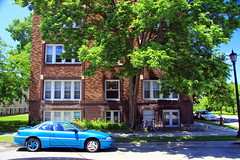Minneapolis, Minnesota (PRWEB) October 19, 2012
Minneapolis and St Paul, widely known as the Twin Cities, are in the top three affordable housing markets nationally, according to a recent survey conducted by interest.com. A median-income household can only afford a median-priced home in 14 of the nation’s 25 largest metropolitan areas. Atlanta, Detroit and Minneapolis - St. Paul are the most affordable cities, according to Interest.com’s first Home Affordability Study. Regardless of low home prices, it is challenging for many families to move and gain affordable housing in today's economy.
| (Photo credit: Mulad) |
“Despite all of the talk about how homes are more affordable than they have been in decades, buying a home is still a big challenge for many American households. Dealing with rising expenses and stagnant wages is a struggle. Even after years of declining home prices and record-low mortgage rates, median-income households are unable to afford a median-priced home in nearly half of the metropolitan areas that we looked at,” says Mike Sante, managing editor of Interest.com.
Homeowners have more purchasing power today. Here is an example of a homeowner with a 20 percent down payment and a conforming home loan:
September 2011 : A $1,000 mortgage payment afforded a purchase price of $202,000
September 2012 : A $1,000 mortgage payment afforded a purchase price of $226,000
The University of St Thomas (UST) Residential Real Estate Index has been developed by the Shenehon Center for Real Estate at the University of St. Thomas Opus College of Business. "Real estate professionals in the Twin Cites have come to depend on the UST study because of it's proven accuracy," states Sprenger. "Having a long history of focused study on the metro, they are the Hutton's we listen to." To correct the overstatement of housing price decline reported by the S&P Case-Shiller Price Index for the Minneapolis– St. Paul metropolitan area, The Shenehon Center for Real Estate indeed has something to say.
Both use a a three-month moving average. Analysis of three submarkets for MSP Metro Area going back as far as 2005 discover that the S&P Case-Shiller Price Index has significantly overstated the price decline for the traditional housing market while understating the loss of value for homes subject to a foreclosure sale. "Since the first quarter of 2005 Case-Shiller has reported an overall decline in market price of 26.7%. Our analysis of traditional housing sales for the same period, with a three-month moving average, reveals a price decline of 4.3%. Short sales and foreclosure sales had price decreases of 19.3% and 22.4% respectively," states UST. That is good news for Minneapolis.
“If median prices are able to remain above last year’s levels through the fall and winter, and into the spring of next year, that will be a good indication that the Twin Cities area housing market has bottomed out and is on the path to a sustained recovery,” said Herb Tousley, director of real estate programs at the university. "In many communities there is a fundamental disconnect between the income families have and the costs of buying a home. Falling house prices haven't solved the problem. They've helped, but they haven't solved it. If you can't afford a home now, it's not going to get better. This is as good as it gets," concluded Jeffrey Lubell, Center for Housing Policy Executive Director.
Take advantage of today's opportunities to build a home or begin a major home remodel project in the Minneapolis and St Paul housing market. Gain professional advice to weigh personal options by calling 952-923-5706.
Taken from: http://www.prweb.com/releases/US-home-affordability/Minneapolis-real-estate/prweb10035348.htm






No comments:
Post a Comment